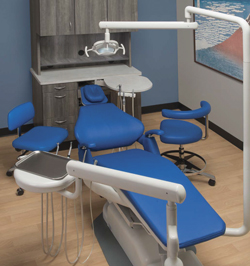 The growth of the large group practice has led to a minimalist philosophy toward dental cabinetry in the treatment room. The challenge to the staff is how to organize and systemize the flow of materials and instruments to efficiently do multiple procedures on a patient. Office designers and equipment suppliers do a good job of helping the group practice equip the office, but they leave a lot to be desired in helping the staff translate this new environment into practicing dentistry more efficiently.
The growth of the large group practice has led to a minimalist philosophy toward dental cabinetry in the treatment room. The challenge to the staff is how to organize and systemize the flow of materials and instruments to efficiently do multiple procedures on a patient. Office designers and equipment suppliers do a good job of helping the group practice equip the office, but they leave a lot to be desired in helping the staff translate this new environment into practicing dentistry more efficiently.
The Royal Dental Group of companies believes in the philosophy of improving productivity.
The key is to implement systems that can handle the flow of materials and instruments. Integrating these systems into the treatment room will maximize productivity and eliminate much wasted effort.
The large group practice should be designed to use a centralized storage approach for handling instruments and materials. This eliminates much duplication of products and instruments, streamlining the flow of materials and instruments into a system. It typically will reduce inventory on hand, as well as improve cash flow for the practice.
Making decisions to standardize the materials and instruments that are going to be used on each individual procedure will lead to work simplification. It will also contribute to a standard of care that is consistent from patient to patient.
The first step in creating a centralized system is to classify your storage needs into three areas: primary, secondary and bulk. Primary storage is the area in the treatment room. Today’s dental treatment room should be designed to utilize a tray or cassette system for the handling of instruments and a procedure tub for the materials that are to be used.
Secondary storage is the area where the backup supplies and instruments are kept to replenish a tub or replace a contaminated tray. Usually, the steri-center is the most logical area for these items. Depending on the size of the practice, a separate set of cabinets for materials and tub replenishing is needed in conjunction with the steri-center, where the instrument processing takes place.
Bulk storage is the location where big items, like cases of towels, bibs, plaster and other large items, are kept. The lab, a storage closet or the basement can be used for storing items that are too large to be kept in the materials area.
Finally, by analyzing the number of patients to be treated and the types of procedures that are completed each month, the practice can determine a protocol for setting up the materials and instrument flow. When multiple procedures are done on the same patient, all the materials and instruments are brought from the secondary storage area to the treatment room. This keeps the focus on treating the patient and limits interruptions during the procedure.
The Royal Dental Group of companies can assist your practice in accomplishing more efficiency with their custom designed cabinets and mobile workstations.
Editor’s note: Sponsored by Royal Dental Group

